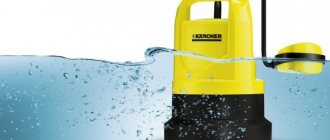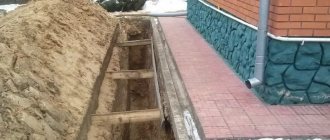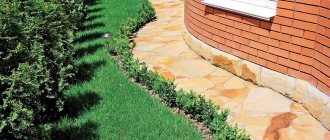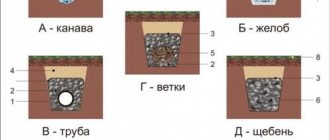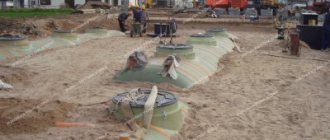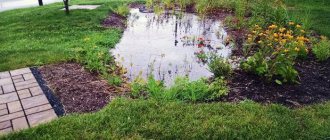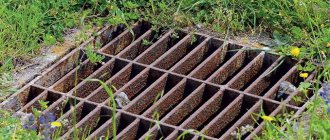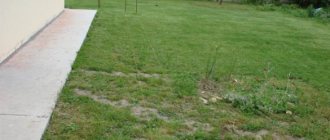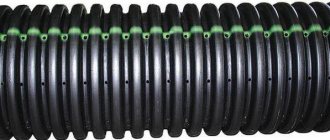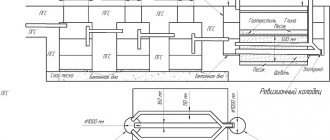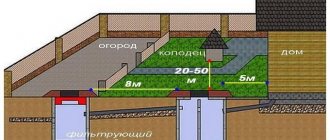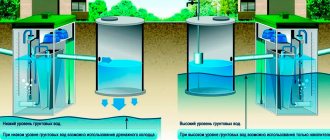What is drainage?
Drainage is a system that removes excess moisture from a building using a pipe structure. There is an opinion that to effectively collect water, only a blind area is enough, but experts in this field recommend installing a full-fledged drainage system, which allows for much better protection of the building from the harmful effects of moisture.
No matter how beautiful the blind area is, it will not completely protect the house from moisture Source pinterest.at
A drainage system for a home can be of three types :
- Open . It is a structure where open type trenches are used as drainage drains, the depth and width of which is 0.5 meters. This is the easiest drainage option for self-installation. The disadvantages of such a system include the unaesthetic appearance, as well as the unreliability of the structure, which will require additional reinforcement of the walls with special trays;
- Zasypnaya . This is a structure where prepared trenches are filled with coarse crushed stone or rubble, and turf is laid on top. The advantage of such drainage is its long service life and ease of installation. In addition to the advantages, there are also disadvantages: low throughput, inability to carry out maintenance;
- Closed . This is done by laying drainage pipes with holes in the ground. This system is efficient and does not have the disadvantages of other systems. Its disadvantage is that the installation is quite complicated.
A closed drainage system is difficult to do correctly without certain skills and knowledge Source handmaster.ru
See also: Contacts of companies that specialize in the installation of water supply and sewerage.
Which pipes to choose for drainage
The vast majority of pipes used when installing a drainage system on a site have standard sizes and differ only in the material of manufacture. The most widely used materials are:
- asbestos cement;
- low-density polyethylene (HDPE);
- polyvinyl chloride (PVC).
Asbestos-cement pipes are affordable, have good physical, technical and operational characteristics and a long service life. Some restrictions on the use of this type of pipe are imposed by the content of asbestos, which can cause respiratory diseases.
PVC pipes successfully combine price and performance characteristics. They are easy to install and have a fairly long service life. Among the shortcomings is the lack of perforation.
HDPE pipes are not much different from their PVC counterparts, but they are more expensive. The slight difference in price is due to the presence of ready-made perforations, so installation can begin without additional processing.
Some types of pipes have an additional outer winding that acts as a filter to prevent clogging of the drainage.
You can save some money when installing a drainage system by making drainage holes in polyvinyl chloride pipes with your own hands and wrapping them with geofabric. The diameter of the drainage pipe is determined by the intensity of groundwater seepage and can range from 50 to 80 mm.
Mistakes made when performing drainage yourself
Installing a drainage system without the participation of specialists is often accompanied by the following mistakes:
- The use of a wall drainage system to ensure the removal of excess moisture in areas with high groundwater levels;
- The use of pipelines in geotextile-type filters in areas with clay soil, which will ultimately lead to their clogging;
- Application of levels during pipeline laying;
- Installation of stormwater wells where drainage wells should be installed;
The most common mistake is to install only one drainage system around the house. As practice shows, this is too little. It is necessary to install a drainage system that will drain water from the roof of the building into a special well.
Also, you should avoid using one pipeline for drainage and storm water around the house, since the drainage will not cope with its functions during rains, which will lead to flooding of the area. Overmoistening of the soil near the foundation can lead to its heaving during frosts, which in turn will have a detrimental effect on the foundation of the house, even to the point of complete destruction.
Soil heaving is one of the serious reasons leading to the destruction of a house Source martand.ru
To make storm drains, orange sewer pipes (designed for soil) and special wells are used where excess water will accumulate, which can later be used to water the vegetation.
Negative impact of groundwater on building structures and cultural soils
The drainage system is a highway consisting of channels and pipelines through which moisture is removed from the land. As a result, the water is recycled in special wells and used for household needs and discharged into the central sewer system.
If excess water is not drained from the territory of buildings, it begins to penetrate concrete, brick, and other building materials and destroy their structure. In addition, moisture causes mold and mildew to appear in basements and basements.
During the cold season, moisture accumulated at the base of the building begins to freeze. It expands and begins to widen existing cracks in the structure of buildings. In some cases, the lack of a drainage system on the territory of residential and industrial buildings leads to a violation of the integrity of the structure and its deviation from the vertical position.
Increased moisture content in the soil has another negative side. This interferes with the normal growth of plants, the appearance of microscopic algae on the soil surface, and even waterlogging of the area.
It is very simple to check whether a drainage system is needed in a particular case. It is enough to pay attention to how long puddles left after rain or melting snow remain on the surface of the area. If they do not dry out for a long time, then the soil is waterlogged and the area requires the creation of a drainage system.
It would be more correct to install a drainage system on the site at the stage of building a house or planting plants. This will reduce the cost of installing drainage and will not disrupt the overall layout of the territory.
Types of drainage systems
The drainage pattern around the house is divided into two main types :
- Superficial (violates the aesthetic appearance of the site);
- Deep (perforated pipelines are used).
Surface drainage
Surface drainage around the house is more affordable, simple and easy to perform all necessary operations. Such drainages cannot cope with groundwater and are used only to drain melt and rainwater. surface drainage systems exist :
- Linear . It is used to drain rain and melt water from the entire area of the site. Through trenches dug in the soil, water is drained into a special well, where it accumulates. Such channels are closed on top with decorative grilles;
- Spot . Used to quickly collect water from one source. This drainage is covered with a special metal grate to prevent clogging. All local points are connected by pipes to the main pipeline, which drains water into the drainage well;
Carefully closed points will not disturb the inhabitants of the yard and will not spoil the exterior of the house Source evkrov.ru
- Open . It is a system of channels and drainage trays designed to drain excess water. Its unhindered movement is ensured by a bevel in the trench at an angle of about 30°, directed towards the main trench or drainage well. The advantage of an open drainage system is its low cost and ease of performing the necessary work. Disadvantages include the destructibility of the trench walls and non-aesthetic appearance;
- Closed . The arrangement is similar to open drainage, except for the use of special trays with decorative gratings, which increases the service life of the structure and also improves safety;
- Zasypnaya . This type of system is used in areas with a small area where it is not practical to install open drainage. The arrangement of backfill drainage begins with digging a channel 1 meter deep (the slope should be directed towards the drainage well). The base of the trench is covered with geotextile, after which it is filled with coarse crushed stone or gravel. To give an aesthetic appearance to the site, the structure is covered with a layer of turf on top. Such drainage of the house and site has its drawbacks, including the impossibility of maintenance during operation without dismantling work.
This is what the backfill moisture protection scheme looks like Source vse-o-kanalizacii.ru
Deep type drainage
In places with high groundwater levels, or in properties with clay soil located in lowlands, a deep drainage scheme around the house is used. Systems of this type must cope with the removal of large volumes of water, so the arrangement process is accompanied by the use of perforated pipes, the diameter of which depends on the amount of liquid being drained.
Types of deep drainage
The above type of internal drainage is divided into:
- Horizontal - drainage channels and pipes are located horizontally in relation to the building.
- Vertical – the channels are located in the vertical direction. These are peculiar wells connected to each other by a complex communications system that uses pumps.
- Combined - combines a combination of horizontal and vertical types of soil drainage systems. The price of a drainage system of this type is quite high, so it is used only in areas with difficult climatic conditions.
The cost of installing turnkey drainage systems
Hiring specialists allows you to avoid many mistakes when arranging a drainage system. There are many companies on the market that provide drainage installation services, including project development and carrying out all the necessary work. The average cost of such services is 2300-5000 rubles per square meter and a depth of 1 to 3 meters, respectively.
Also, additional services may be offered, which are paid separately:
- Laying a pipeline for a storm sewer system. The cost of laying pipes to a shallow depth on average reaches 1,000 rubles per linear meter, and laying to a freezing depth is available at a price of about 1,800 rubles;
- The cost of manufacturing a manhole depends on the installation depth and reaches approximately 7,000-10,000 rubles for a recess of 1.5-3 meters, respectively;
When connecting pipes to a manhole, it is important to ensure that the joints are tight Source saratov.tiu.ru
- Installation of a storm drain is available at an average price of 4,000 rubles.
Important! It is better to sign contracts for the installation of turnkey drainage systems with trusted companies that provide a warranty period, which should be at least 3 years.
The price for drainage installation is cumulative and depends on the following conditions:
- Area of the site (cost calculation depends on the length of the canals);
- Complex of necessary works ;
- Slope angle (height between the top and bottom points of the trench);
- Soil type (work on wet clay soil is more expensive than work on regular soil);
- Groundwater level (deep drainage is more expensive than surface drainage).
In what cases is a drainage device necessary?
All of the above problems associated with high soil moisture can be eliminated or prevented with the help of a properly designed drainage system that promptly removes excess moisture outside the site or into a special container. There are a number of signs that clearly indicate the need for drainage:
- after rain, puddles and dirt remain on the site for a long time;
- garden trees and house plants die for no apparent reason;
- intensive mold formation in basements;
- the soil remains moist even during short-term droughts;
- a large number of weeds that love moisture, for example, nettles or cattails;
- location of the site in a wetland or near a body of water.
Important! There are signs by which it can be clearly determined that groundwater flows no more than 1.5 m from the ground surface. With such a depth of the aquifer, a mandatory drainage system is required.
Creating drainage along the fence
In areas with high rainfall, when the terrain slopes towards the fence and there is high water, a drainage ditch along the fence is required. Its creation will be the optimal solution for protecting the base of the fence and rational drainage of water. For useful tips on site drainage, watch this useful video:
There are three types of drainage ditches along the fence:
- closed, created using perforated buried pipes;
- open (gutter);
- backfill, when large crushed stone and other filter mixtures are brought into the prepared trench.
Before making a drainage ditch, you should take into account SNiP 2.05.07-85 and the set of rules numbered 104-34-96. They regulate the requirements for slopes and distances to the fence, and also provide recommendations for practical construction.
A sufficient distance from the fence to the trench with reinforced sides is about 50 cm.
Ditch walls are often made of concrete.
Ditch walls are often created in the form of a concrete trench. Effective options for strengthening slopes are also:
- dense plantings (slope no more than 30°);
- the use of sheets of polymers with large cells, folded in several layers (slope angle - up to 70°);
- biomats are used on slopes up to 60°;
- deep trenches are reinforced with reinforced structures filled with drainage compounds.
The process of creating an open-type ditch consists of the following stages:
- Initially, ditches are dug with a volume twice as large (the required volume);
- the bottom is covered with a cushion of coarse sand or gravel;
- the walls of the resulting gutter are strengthened mechanically or manually, after which they can be decorated;
- it is taken into account that the depth of the pit exceeds the vertical dimensions of the foundations of nearby structures by 30-50 cm;
- The bottom slope is on one side and is up to 5 cm per 10 m of ditch length. For an example of an original drainage ditch, see this video:
The main function of drainage along fences is to redirect the resulting water flows.
